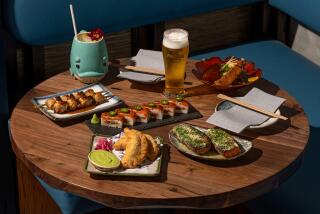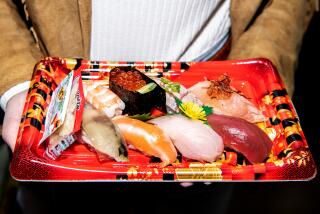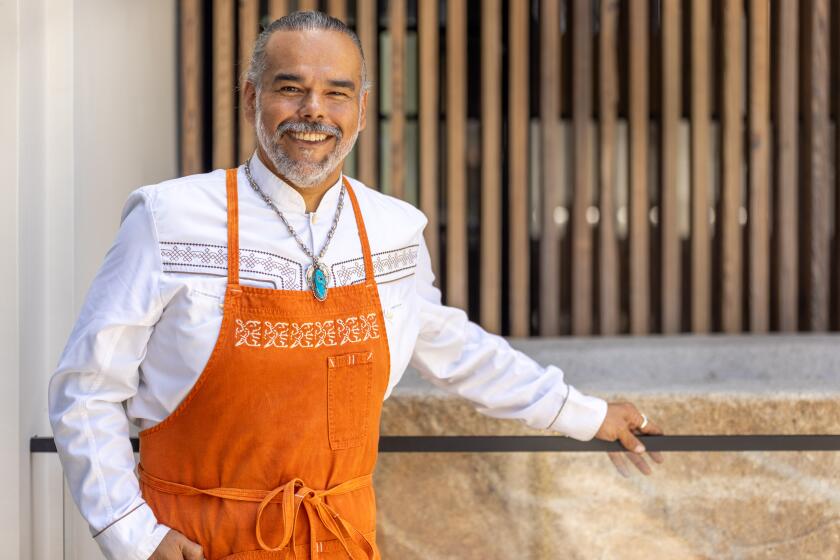Prosperityâs Food : A Japanese delicacy puts added spice into festive year-end celebrations.
For many celebrants, New Yearâs entails a party scenario complete with colorful hats, horns, confetti, snacks, champagne--and burdock root?
Maybe so, if you ring in the New Year Japanese style. In Japan, burdock root is an integral part of a celebratory feast that welcomes in the New Year. According to local grower Dwight Fuji, the ritualistic feast is steeped in tradition and symbolism and has been practiced for centuries.
According to Japanese tradition, Fuji said, the feast consists of foods that can ensure good health and prosperity. âItâs all about starting the New Year off on the right foot,â Fuji said.
But the mild-flavored burdock root--a long, slender taproot of the daisy family--is not only eaten during the holidays. Gobo , as it is called in Japan, is a popular addition to many Japanese dishes and is eaten throughout the year.
âIt has sort of a gourmet image,â Fuji said. âAlthough widely available, it is not a standard item like, say, the carrot is here.â
Fuji is co-owner of the family-run Gardena Nursery in Camarillo. He said the nursery delivers much of the burdock root used in restaurants in the Los Angeles area. The nursery also offers burdock root and assorted other Asian vegetables at the Thousand Oaks (Thursdays) and Ventura (Saturdays) farmersâ markets.
Youâre unlikely to see burdock root at your local grocery store. A few specialty markets in Ventura County carry it, but otherwise, itâs hard to find locally, said Fuji.
The long, slender root grows to three feet or longer and ranges from 1/2- to 3/4-inch in diameter.
âIf cooked properly it is quite tender with a certain crispness,â Fuji said. âIt is mildly sweet and has an earthy taste and aroma.â Overcooked, itâs rubbery, he said.
Fuji prefers to julienne the root into slices about two inches long. Thereâs no need to peel; simply scrape the outside with the blade of a knife. After slicing immediately place it into cool water, as the grayish-white flesh will quickly brown. Using a wok or frying pan and a little sesame oil, saute for a few minutes with a little sake, sugar and soy sauce. Thatâs the makings for kinpira gobo, Fuji explained.
New Yearâs celebration recipes are many and some are more difficult to prepare than others. The most common, though, is nishime. Cut burdock root in 1/2-inch diagonal slices and simmer in a fish broth for 10 minutes. Strain, salt to taste and serve as an hors dâoeuvre. Other feast foods include fish eggs, to ensure fertility, and shrimp and lobster, which represent longevity.
âI try to keep it in year-round, but itâs not really a big seller,â said Cliff Kersey, produce manager at Mrs. Gooches in Thousand Oaks. âMost people donât know what it is or how to use it.â Because burdock root remains an item not widely available, it does not command premium prices.
Kersey said it usually retails for about $4.98 per pound, but Mrs. Gooches is selling it for 98 cents per pound and will continue to do so for the next couple of days. (You might want to call ahead to be sure, 492-5340).
Youâll also find fresh burdock root at Lassenâs Health Foods in Ventura and a dried shredded form--which can be used for teas--at Lassenâs in Oxnard.
When purchasing burdock root, he said to choose roots that are firm and not flabby. Store it in plastic bags to keep it from dehydrating. Fuji said it can last in the refrigerator for a couple months.
More to Read
Eat your way across L.A.
Get our weekly Tasting Notes newsletter for reviews, news and more.
You may occasionally receive promotional content from the Los Angeles Times.










